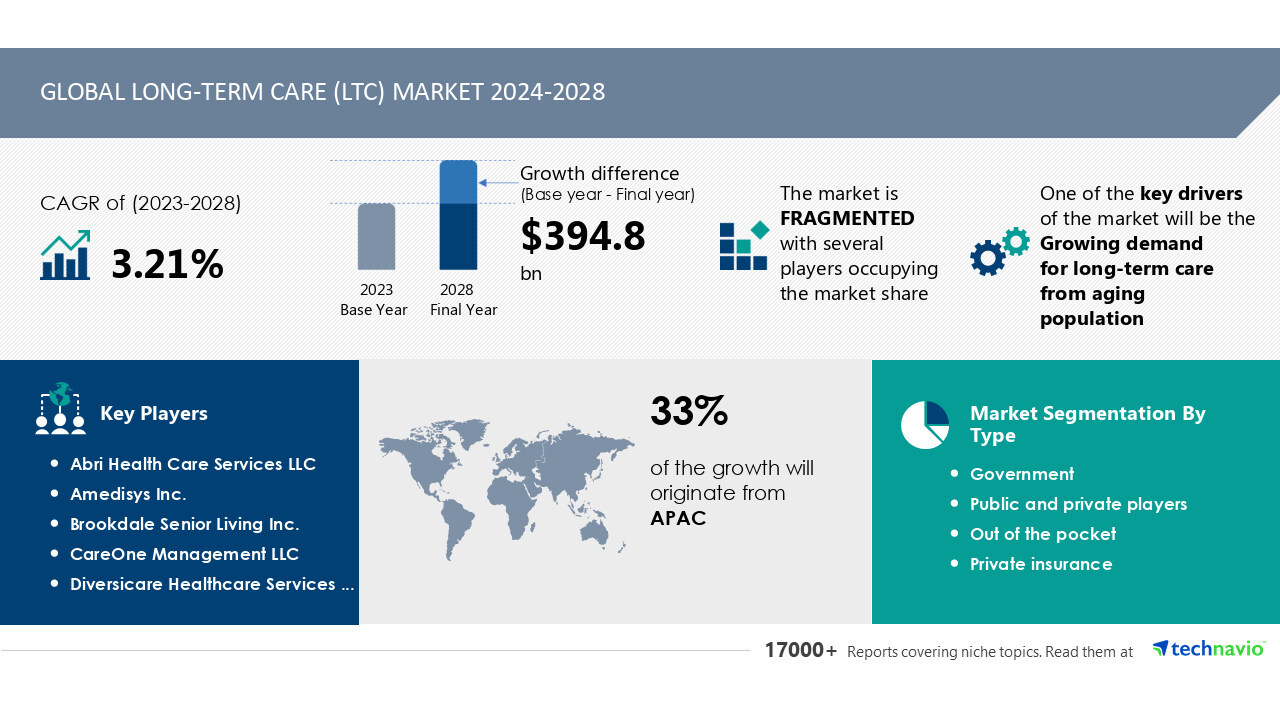
NEW YORK , Nov. 8, 2024 /PRNewswire/ -- Report on how AI is redefining market landscape - The global long-term care (LTC) market size is estimated to grow by USD 394.8 billion from 2024-2028, according to Technavio.
The market is estimated to grow at a CAGR of over 3.21% during the forecast period. Growing demand for long-term care from aging population is driving market growth, with a trend towards expansion and growth of several healthcare domain.
However, lack of skilled nursing staff for long-term care poses a challenge.Key market players include Abri Health Care Services LLC, Amedisys Inc., Brookdale Senior Living Inc.
, CareOne Management LLC, Diversicare Healthcare Services Inc., Extendicare Canada Inc, FCP Live In, Genesis Healthcare Inc., Honor Technology Inc.
, Illumifin Corp., Kindred Health Holdings LLC, Life Care Centers of America Inc., Revera Inc.
, SeniorLiving.org, Sonida Senior Living Inc., Sunrise Senior Living LLC, and Wickshire Senior Living.
Key insights into market evolution with AI-powered analysis. Explore trends, segmentation, and growth drivers- View Free Sample PDF Market Driver The Long-Term Care (LTC) market is experiencing significant growth due to the increasing chronic diseases prevalence among the geriatric population. Chronic illnesses such as osteoporosis, hypertension, diabetes, cancer, Alzheimer's, and dementia affect a large portion of the older population, leading to a high demand for LTC services.
Home healthcare, nursing homes, assisted living facilities, adult daycare, hospices, and nursing care are popular options for those requiring long-term care. Formal professionals and unpaid family members, partners, friends, and neighbors provide care for the sick, disabled, and chronically ill. The government and commercial insurers are key funding sources for LTC, with the target demographic being the elderly population with multimorbidity.
Competent nursing staff, medication management, basic health services, counseling services, and mental health are essential components of quality LTC. Technologies like durable medical devices, walkers, wheelchairs, safety blankets, internet-enabled monitoring, telemedicine, and mobile health apps are transforming healthcare delivery. Stringent regulations ensure quality care, patient safety, and standards in the nursing home sector.
Emerging alternatives like palliative care and hospice services cater to unmet needs in LTC. Life expectancy continues to rise, increasing the demand for LTC services, and healthcare systems must adapt to meet the needs of this growing population. The long-term care (LTC) market is experiencing significant growth due to several factors.
Healthcare facilities are transitioning into patient-focused service providers, leading to new vendors entering the market and advancements in treatment therapies and techniques. Infrastructure improvements and the availability of skilled professionals are also contributing to market expansion. Increased healthcare spending on diagnostics, hospital treatments, and home-based care services post-treatment are driving the demand for long-term care services.
Consequently, vendors are investing in advanced laboratories, patient wards, and medical equipment to cater to this growing need. However, this expansion brings challenges to the global LTC market, particularly in terms of managing the increasing patient pool and ensuring quality care. Request Sample of our comprehensive report now to stay ahead in the AI-driven market evolution! Market Challenges The Long-Term Care (LTC) market faces significant challenges due to the growing geriatric population and the prevalence of chronic diseases such as osteoporosis, hypertension, diabetes, cancer, Alzheimer's, and dementia.
This demographic shift increases the demand for various LTC services, including home healthcare, nursing homes, assisted living facilities, adult daycare, and hospices. Chronic illnesses and multimorbidity require intensive medication management, personal care, and basic health services. Formal professionals and unpaid family members, partners, friends, and neighbors provide care for the sick, disabled, and elderly.
Governments and commercial insurers are essential stakeholders in addressing the unmet needs of the LTC sector. Competent nursing staff, stringent regulations, quality of care, and patient safety are crucial factors in ensuring the effectiveness and sustainability of LTC services. Emerging technologies, such as healthcare delivery technology, durable medical devices (walkers, wheelchairs, safety blankets), Internet-enabled monitoring, telemedicine, and mobile health apps, offer promising solutions to enhance the delivery of LTC services while addressing the challenges of chronic disease prevalence, hospitalization, and mental stress.
Palliative care and counseling services for mental health are essential components of comprehensive LTC, as mental illnesses often co-occur with physical illnesses. The nursing home sector must adapt to these challenges by focusing on patient-centered care, investing in technologies, and complying with evolving standards. The long-term care market faces a significant challenge in securing sufficient providers and healthcare professionals, particularly in geriatrics.
A scarcity of primary care physicians and caretakers persists, exacerbated by a shortage of trained nurses. Many nurses opt for management roles, leaving long-term care sites understaffed. Isolation is common in the industry, prioritizing tasks over patient care.
Consequently, some facilities have halted new patient admissions or discontinued care for current residents. This trend diminishes the quality of services offered in long-term care facilities. Discover how AI is revolutionizing market trends- Get your access now! Segment Overview This long-term care (ltc) market report extensively covers market segmentation by 1.
1 Government 1.2 Public and private players 1.3 Out of the pocket 1.
4 Private insurance 2.1 Nursing care and assisted living facilities 2.2 Home healthcare 2.
3 Hospice 3.1 North America 3.2 Europe 3.
3 APAC 3.4 South America 3.5 Middle East and Africa 1.
1 Government- The long-term care (LTC) market is significantly influenced by government initiatives. Governments worldwide are focusing on financing long-term care services for their citizens, particularly for those with limited resources. This trend is crucial for families to consider long-term care needs as part of their retirement planning.
The Indian government, for instance, has increased healthcare expenditure to 18.3% of GDP in FY22-23, allocating Rs.86 ,200.
65 Cr ( USD 11.28 billion ) to the Ministry of Health and Family. Such investments underscore the importance of government involvement in the LTC market, driving its growth during the forecast period.
Download a Sample of our comprehensive report today to discover how AI-driven innovations are reshaping competitive dynamics Research Analysis The long-term care (LTC) market caters to the unique needs of the geriatric population, who often suffer from chronic diseases such as cancer, Alzheimer's, Dementia, and heart problems. Chronic illnesses and multimorbidity are prevalent among the elderly population, leading to a high demand for LTC services. These services include home healthcare, nursing homes, nursing care, assisted living facilities, adult daycare, hospices, and formal professional care, as well as the crucial role of informal caregivers.
Unmet needs in LTC are significant, with basic health services, medication management, dressing, and mobility assistance being essential requirements. Governments and healthcare systems are increasingly recognizing the importance of LTC and are investing in its development. However, the complexities of chronic diseases and the diverse needs of the elderly population necessitate a comprehensive approach to LTC, integrating various services and addressing the interplay between physical and mental illnesses.
Market Research Overview The Long-Term Care (LTC) market caters to the unique needs of the geriatric population, who often suffer from chronic diseases such as osteoporosis, hypertension, diabetes, cancer, Alzheimer's, and dementia. Chronic illnesses and disabilities in older adults lead to multimorbidity, requiring extensive care and medication management. The target demographic includes the sick, disabled, and elderly population, who may require various forms of care, including nursing care, home healthcare, assisted living facilities, adult daycare, hospices, and nursing homes.
Formal professionals and competent nursing staff play a crucial role in providing basic health services, while unpaid family members, partners, friends, and neighbors often serve as informal caregivers. Government funding and commercial insurers contribute significantly to the LTC sector. The LTC market encompasses a wide range of services and technologies, including counseling services for mental health, durable medical devices like walkers and wheelchairs, safety blankets, and healthcare delivery technology such as Internet-enabled monitoring, telemedicine, and mobile health apps.
Stringent regulations ensure quality of care and patient safety, while emerging alternatives like palliative care and hospice services address unmet needs in the LTC sector. The LTC market is a critical component of healthcare systems, addressing the healthcare needs of an aging population with chronic illnesses and disabilities. Table of Contents: 1 Executive Summary 2 Market Landscape 3 Market Sizing 4 Historic Market Size 5 Five Forces Analysis 6 Market Segmentation Type Government Public And Private Players Out Of The Pocket Private Insurance Application Nursing Care And Assisted Living Facilities Home Healthcare Hospice Geography North America Europe APAC South America Middle East And Africa 7 Customer Landscape 8 Geographic Landscape 9 Drivers, Challenges, and Trends 10 Company Landscape 11 Company Analysis 12 Appendix About Technavio Technavio is a leading global technology research and advisory company.
Their research and analysis focuses on emerging market trends and provides actionable insights to help businesses identify market opportunities and develop effective strategies to optimize their market positions. With over 500 specialized analysts, Technavio's report library consists of more than 17,000 reports and counting, covering 800 technologies, spanning across 50 countries. Their client base consists of enterprises of all sizes, including more than 100 Fortune 500 companies.
This growing client base relies on Technavio's comprehensive coverage, extensive research, and actionable market insights to identify opportunities in existing and potential markets and assess their competitive positions within changing market scenarios. Contacts Technavio Research Jesse Maida Media & Marketing Executive US: +1 844 364 1100 UK: +44 203 893 3200 Email: [email protected] Website: www.technavio.
com/ SOURCE Technavio.














